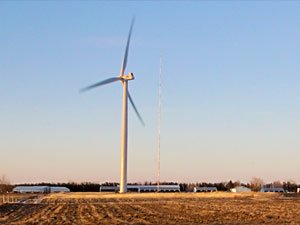U of M among three winners of new federal wind energy grant

A University-led consortium will receive up to $8 million for wind power research and education
By Deane Morrison
Years of research and investment in wind energy generation paid off for the University of Minnesota Thursday (October 15, 2008), when U.S. Energy Secretary Steven Chu named a U of M-led consortium and two others to share up to $24 million for wind energy research and education.
The grant, funded from the American Recovery and Reinvestment Act, will support research to improve both land-based and offshore wind generation. The University of Minnesota-led group stands to receive up to $8 million.
"We're thrilled," says Rod Larkins, associate director of the Initiative for Renewable Energy and the Environment (IREE), a signature program of the University's Institute on the Environment.
Wind power has been around for centuries, but the modern field has a crying need for investment and improvement, Larkins says. For one thing, its efficiency is low, so investments take a long time to pay themselves off. Also, turbines wear out and break down, sometimes catastrophically.
'since they're so big and bulky and there's so much stress on the towers and foundation, they tend to be overbuilt, and people haven't found the optimal construction," he explains.
Perhaps most important, however, is the lack of infrastructure, both technological and human.
"Who are the next generation of scientists working on these turbines? We need a university department training students to do this," Larkins says. Also needed, he adds, are the means and people to build and repair wind energy structures.
The University's consortium comprises academic and industrial partners working to improve the efficiency of wind power and educate a generation of scientists and engineers to specialize in wind energy technology. Fotis Sotiropoulos, professor in the University's Institute of Technology (IT) and director of its St. Anthony Falls Laboratory, along with other researchers from IT and the University of Minnesota, Morris, lead the consortium.
The group began years ago, when IREE invested in U of M faculty wind research projects and also provided more than $500,000 in matching research funds. One major project is under way at the Morris campus, which is now in the process of integrating multiple wind turbines and distributed storage into a campus microgrid.
"The University of Minnesota, Morris, and its research partner, the West Central Research and Outreach Center, are pleased to be partners in this grant," says Lowell Rasmussen, vice chancellor for finance and facilities for the Morris campus. "We appreciate that the Department of Energy recognizes that we are a combination of leading companies and institutions drawing on resources such as the tremendous capabilities of the U of M."
Among faculty wind energy projects are mechanical engineering professor Kim Stelson's work to make the wind power transmission system more durable. Now, problems arise when the wind blows too fast and puts pressure on the system. Another is one by Susan Mantell, also a mechanical engineering professor, to place sensors on turbine blades to detect signs of failure before they become acute--and expensive to fix.
Larkins credits the state of Minnesota's support of wind power for helping set the stage for the University's successful pursuit of the new grant.
"Minnesota is fourth with respect to wind energy generated in the United States," says Larkins. "But what really separates us is the combination of the University and industrial collaborators [in this state] to drive the technology forward."
The U of M plans to install a new Siemens 2.3 MW turbine research facility at the University of Minnesota Outreach Research and Education (UMore) Park in Rosemount, Minn., to study novel mechanical power transmission and electric generator systems. Besides Siemens Energy, industrial partners include Barr Engineering, Eaton Corporation, Honeywell, Lockheed Martin, Luna Innovations, 3M and WindLogics. Academic partners include Syracuse University and Dakota County Technical College.
The grant will also allow students to benefit from instruction focused on wind power technologies and integration with other renewable energy sources, and from internships with industrial partners at consortium field sites.
The other two grant awardees are consortia led by the Illinois Institute of Technology and the University of Maine. More details are available from the DOE news release.
